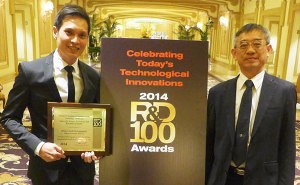Nov 26 2014
A Flexure-Based Electromagnetic Linear Actuator (FELA) developed by the Singapore Institute of Manufacturing Technology (SIMTech), a research institute of the Agency for Science, Technology and Research (A*STAR), is the only locally-developed innovation featured in the 2014 R&D 100 Awards, an international competition that recognises the 100 most technologically-significant products introduced into the marketplace over the past year.
 Dr Daniel Teo Tat Joo, Research Scientist and FELA inventor (left) with Dr Lim Ser Yong, Executive Director, SIMTech, A*STAR (right).
Dr Daniel Teo Tat Joo, Research Scientist and FELA inventor (left) with Dr Lim Ser Yong, Executive Director, SIMTech, A*STAR (right).
FELA was accorded the prestigious award as it successfully broke through a crucial barrier encountered by the state-of-the-art nano-positioning actuators.
Actuators with nano-positioning capability play a crucial role in realising high-precision performance in many industrial equipment and instruments. FELA is a new class of nano-positioning actuators that have successfully broken through the millimetres travel range, a limit encountered by other nano-positioning actuators. What makes FELA unique and applicable to an array of precision instruments and equipment is its ability to deliver superior nano-positioning capability with the flexibility to configure the output resolution at an extremely affordable price, all contained within a single package.
The development of this technology is critical for the next generation of high-precision systems such as the nano-imprint lithography systems, micro-/nano-scale positioning systems, micro-/nano-metrology systems, micro-/nano-machining systems, micro-/nano-manipulation systems, and bio-medical instruments. Its high energy-efficiency and simplicity of construction, coupled with its maintenance-free and low cost bearings help make FELA a cost effective solution that will bring about game-changing impact in a wide range of high-precision systems.
Dr Lim Ser Yong, Executive Director of SIMTech said, "The ground-breaking FELA which yields millimetres travel range with nanometre-level positioning accuracy offers a new generation of cost effective high-precision systems for the Precision Engineering industry. We are honoured that FELA has been recognised as a significant global innovation by the R&D 100 Awards. This is a testament to the capability and talent in Singapore's research and development ecosystem for developing and commercialising valued technologies in advancing high-precision systems."
The invention was licensed to MicroSteel Precision Pte Ltd, a manufacturer of precision components. This award winning technology has since transformed the local SME from a machining house to a precision machine developer for leading manufacturers and suppliers of optoelectronics components and sub-systems. With the added services, the company could also upgrade its engineers' skill sets to machine integration, and control programming respectively. This is crucial for the industry to adapt to the changing manufacturing landscape.
Notes to Editor:
The R&D awards, widely known as "Oscars of Innovations", have been given out annually by R&D Magazine since 1963 for the most outstanding new products or processes that were developed and commercialised during the previous year. The awards recognise excellence across a wide range of industries, including telecommunications, optics, high-energy physics, materials science, chemistry and biotechnology. Winners include established Fortune 500 companies and others are federally funded research institutions, academia and government labs such as NASA, Lawrence Livermore National Laboratory, Oak Ridge National Laboratory, Massachusetts Institute of Technology, Stanford University, Bell Laboratories, General Electric Co., Hewlett-Packard Co., IBM Corp, 3M, Carl Zeiss, Hitachi Ltd, and Toyota Motor Corp.
Since 1963, the R&D 100 Awards have identified revolutionary technologies newly introduced to the market. Many of these have become household names, helping shape everyday life. These include the instant colour process film, Polaroid, (1963), the ink-jet printer (1967), the colour copier (1968), the lithium batteries (1971), the automated teller machine, ATM, (1973), the halogen lamp (1974), the fax machine (1975), high-speed CMOS RAM (1978), the liquid crystal display, LCD, (1980), the personal supercomputer (1987), the Kodak Photo CD (1991), the anti-smoking patch (1992), CD player/recorder (1993), anticancer drug (1993), lab on a chip (1996), HDTV (1998), intelligent parking assist (2004), iRobot (2006), and artificial retina (2009).
More recent breakthroughs that have earned R&D 100 Awards include next-generation magnetic resonance imaging machines, laser-based metal-forming tools, and the building blocks for fusion experiments. A full list of the 2014 R&D 100 Award winners can be found here. http://www.rdmag.com/award-winners/2014/08/2014-r-d-100-award-winners